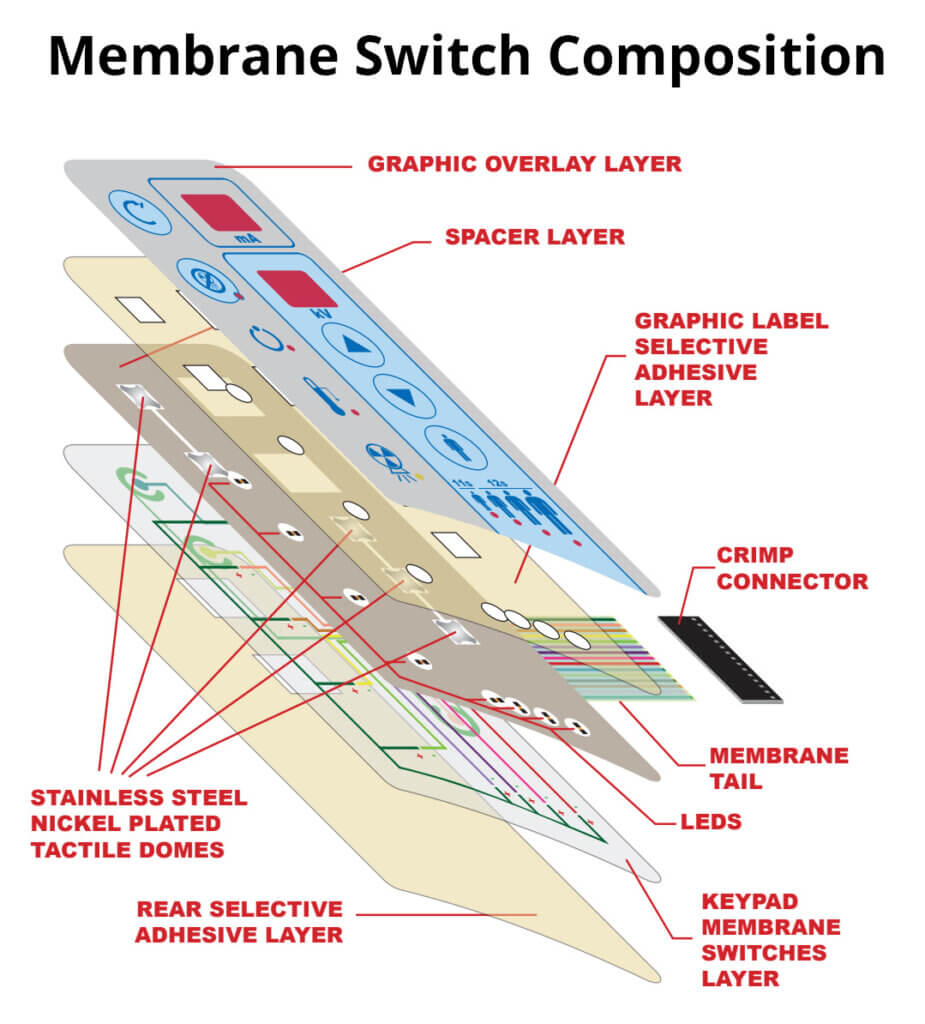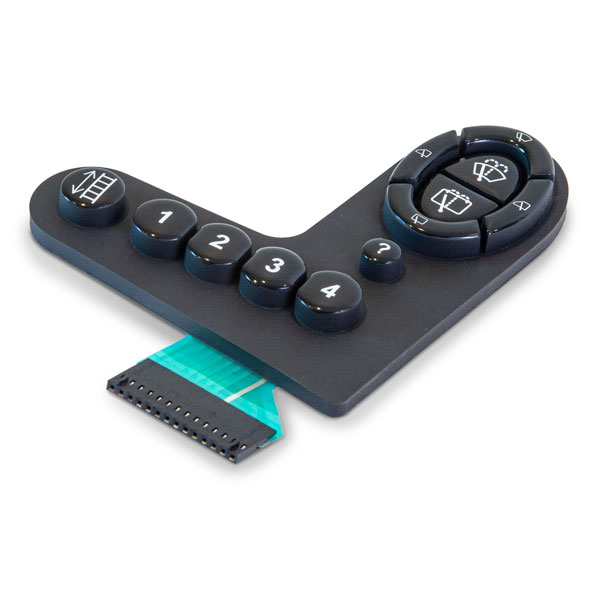How membrane switch is helping modernize industrial workflows
Wiki Article
The Manufacturing Process Behind Membrane Layer Change: What You Required to Know
The manufacturing procedure behind membrane switches over combines mindful style, material option, and quality assurance. It starts with understanding the ins and outs of membrane layer button layout and proceeds through numerous phases, consisting of material selections and printing techniques. Each phase plays a crucial duty in making sure performance and toughness. The complexities of layer building and construction and the extensive screening requirements may expose understandings that are not right away apparent. What lies past these fundamental aspects?Comprehending Membrane Switch Over Style
Although membrane layer buttons may show up straightforward at very first look, their layout includes intricate factors to consider that ensure performance and resilience. The style procedure begins with a complete understanding of individual needs, consisting of the user interface's intended application and ecological elements. Comfort designs is a crucial element, as the format should help with ease of usage while making certain that responsive feedback satisfies individual expectations.Moreover, the layering of elements, such as graphic overlays, glue layers, and conductive traces, must be exactly engineered. membrane switch. This split arrangement not only influences the switch's responsiveness however likewise impacts its durability. Focus is given to the securing techniques employed to safeguard versus dampness and dust, which can endanger efficiency. In addition, style considerations encompass appearances, where color design and visual quality enhance customer experience. Inevitably, the layout of membrane switches equilibriums performance, user experience, and durability, ensuring that they satisfy the needs of various applications efficientlyMaterials Used in Membrane Layer Change Manufacturing
When choosing materials for membrane button manufacturing, it is vital to consider both efficiency and sturdiness. The main materials consist of polyester and polycarbonate movies, which offer versatility and strength. These movies are usually coated with sticky to ensure correct bonding to substrates. Conductive inks, normally made up of silver or carbon, are crucial for developing electric connections within the button, enabling reliable operation.Additionally, a safety layer, such as a tough coat, is often put on boost scrape resistance and durability. The option of backing product, such as acrylic or foam, can considerably impact the switch's tactile feeling and overall user experience. In addition, various environmental factors, consisting of temperature and humidity, need to guide material option to ensure peak efficiency in details applications. Ultimately, the ideal combination of products adds to the membrane layer switch's capability and life expectancy, making notified options important for makers.The Printing Process: Creating Graphics and Text
The printing process in membrane layer button manufacturing plays a substantial role in creating high-quality graphics and message. Different graphic layout strategies are utilized to guarantee aesthetic charm and capability, while careful ink selection methods are crucial for resilience and efficiency. Understanding these components is essential for attaining best lead to membrane layer button style.Graphic Style Techniques
Graphic layout strategies play an essential duty in the printing procedure of membrane buttons, as they define how graphics and message will ultimately show up on the end product. Reliable visuals style involves the tactical use of shades, fonts, and formats to boost readability and visual charm. Designers usually use vector graphics for scalability, making sure that images remain sharp at numerous dimensions. Additionally, attention to comparison and positioning is essential, as it affects user interaction and visual top quality. The incorporation of branding components, such as logos, need to be managed with treatment to keep brand name honesty. In general, thoughtful visuals design techniques contribute substantially to the capability and beauty of membrane layer switches, impacting individual experience and item performance.Ink Selection Methods
Selecting the proper ink is crucial for accomplishing the wanted aesthetic top quality and longevity in membrane button manufacturing. Various ink types are made use of, consisting of solvent-based, water-based, and UV-curable inks. Each type supplies distinctive features, such as adhesion, versatility, and resistance to environmental variables. Solvent-based inks are frequently favored for their resilience and dynamic shades, while water-based inks are much more environmentally pleasant but might have restrictions in attachment. UV-curable inks provide rapid curing and robust efficiency. Additionally, shade matching strategies assure that the selected inks line up with layout requirements. Eventually, the selection of ink need to think about factors such as application technique, substrate compatibility, and end-use demands to achieve superior cause membrane layer switch graphics and text.Layer Construction and Setting Up

Product Option Refine
A careful choice of products is crucial in the manufacturing procedure of membrane layer switches, as it directly influences capability and durability. The key materials made use of consist of polyester, polycarbonate, and different conductive inks. Polyester is frequently preferred for its exceptional resistance to chemicals and abrasion, making it ideal for rough environments. Polycarbonate, on the other hand, gives exceptional clarity and influence resistance, which is helpful for applications requiring visibility and effectiveness. Conductive inks, commonly composed of silver or carbon, are crucial for creating dependable electric paths. Additionally, the option of adhesive products impacts the overall honesty of the switch - membrane switch. Evaluating aspects such as environmental direct exposure, tactile feedback, and aesthetic requirements overviews suppliers in selecting the very best products for their specific applicationsLayer Attachment Methods
Sticking layers in membrane layer button useful link building and construction is a vital process that ensures functionality and durability. Numerous attachment strategies are used to secure optimal bonding between layers, which usually include using adhesives, warmth, and stress. Pressure-sensitive adhesives (PSAs) are generally utilized for their ease of application and instant bonding capacities. In addition, thermal bonding methods can be applied, where warm is made use of to trigger sticky buildings, protecting a strong bond. The option of attachment approach mostly depends upon the materials included and the details application needs of the membrane button. Correct positioning and consistent application of adhesives are important to prevent flaws, safeguarding the button operates efficiently throughout its desired lifespan.Quality Control Steps
Guaranteeing top quality control during the layer construction and setting up of membrane layer buttons is crucial for maintaining performance and integrity. This procedure generally entails several essential procedures, consisting of thorough assessments at each phase of manufacturing. Suppliers use sophisticated testing techniques, such as peel examinations and adhesion evaluations, to validate the integrity of layer bonds. In addition, visual assessments are conducted to recognize any kind of problems in printing or product variances. Ecological conditions, such as temperature and moisture, are meticulously checked to ensure suitable treating and bond. Additionally, routine calibration of devices helps maintain accurate production criteria. By implementing these quality assurance actions, producers can considerably minimize the risk of product failing, assuring that the final membrane switches satisfy the needed specifications and client assumptions.Checking and High Quality Control Measures

Innovations in Membrane Switch Over Modern Technology
As developments in technology remain to develop, membrane buttons are taking advantage of innovative developments that boost their performance and user experience. One remarkable development is the combination of capacitive touch technology, which permits more receptive and intuitive customer interfaces. This shift not only improves looks yet additionally reduces mechanical deterioration, expanding the life-span of the switches.Additionally, improvements in visuals overlay materials have caused boosted resilience and resistance to ecological elements such as dampness and UV light. These products now use boosted clearness and brightness, further boosting the aesthetic appeal.Furthermore, the incorporation of wise technology is transforming membrane switches into interactive control board, allowing connection with IoT devices. This connection cultivates a seamless individual experience, paving the means for applications in different markets, from health care to customer electronics. Collectively, these developments setting membrane switches over as important components in modern tool layout.Frequently Asked Questions
The length of time Does the Membrane Layer Switch Manufacturing Process Take?
The duration of the membrane layer button production procedure can browse around this web-site differ substantially. Aspects such as intricacy, materials made use of, and manufacturing volume influence timelines, with regular manufacturing varying from a few days to a number of weeks for completion.What Are the Typical Applications for Membrane Layer Switches?
Membrane layer buttons are commonly made use of in various sectors, consisting of vehicle controls, family home appliances, medical gadgets, and customer electronic devices (membrane switch). Their flexibility and sturdiness make them suitable for applications needing user-friendly user interfaces and trusted efficiency in varied settingsCan Membrane Layer Switches Over Be Personalized for Details Demands?

What Is the Life expectancy of a Normal Membrane Change?
The life-span of a normal membrane layer switch varies, yet typically, it varies from 1 to 5 million cycles. Variables such as usage, environment, and material top quality considerably affect resilience and overall efficiency gradually.

Are Membrane Layer Switches Over Eco Pleasant?
The environmental kindness of membrane switches differs. Some products utilized may not be recyclable, while others can be eco-friendly. The general influence relies on producing materials and techniques, requiring careful consideration during option and disposal. The production procedure behind membrane layer changes combines careful layout, material selection, and quality control. It starts with comprehending the complexities of membrane layer button layout and advances via different stages, including product choices and printing techniques. When picking materials for membrane switch production, it is vital to consider both performance and longevity. A cautious option of materials is essential in sites the manufacturing process of membrane switches, as it directly influences functionality and longevity. The option of bond technique largely depends on the products involved and the certain application requirements of the membrane switch.Report this wiki page